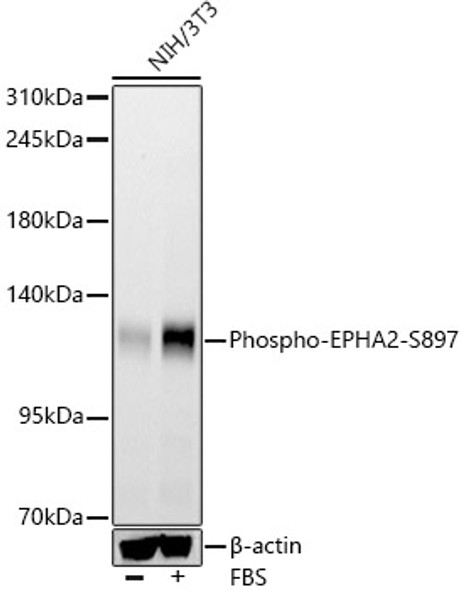Description
| Antibody Name: | Phospho-BLM (T99) Antibody (PACO05014) |
| Antibody SKU: | PACO05014 |
| Size: | 50ug |
| Host Species: | Rabbit |
| Tested Applications: | ELISA, WB, IHC, IF |
| Recommended Dilutions: | ELISA:1:5000, WB:1:500-1:2000, IHC:1:100-1:300, IF:1:200-1:1000 |
| Species Reactivity: | Human |
| Immunogen: | Synthesized peptide derived from human BLM around the phosphorylation site of T99. |
| Form: | Liquid |
| Storage Buffer: | Liquid in PBS containing 50% glycerol, 0.5% BSA and 0.02% sodium azide. |
| Purification Method: | The antibody was affinity-purified from rabbit antiserum by affinity-chromatography using epitope-specific immunogen. |
| Clonality: | Polyclonal |
| Isotype: | IgG |
| Conjugate: | Non-conjugated |
| Synonyms: | BLM; RECQ2; RECQL3; Bloom syndrome protein; DNA helicase; RecQ-like type 2; RecQ2; RecQ protein-like 3 |
| UniProt Protein Function: | BLM: a magnesium-dependent ATP-dependent DNA-helicase that unwinds single- and double-stranded DNA in a 3'-5' direction. A member of the RecQ helicase family that is required for genome stability. Participates in DNA replication, recombination and repair. Part of the BRCA1-associated genome surveillance complex (BASC), which contains BRCA1, MSH2, MSH6, MLH1, ATM, BLM, PMS2 and the RAD50-MRE11-NBS1 protein complex which is a dynamic process changing throughout the cell cycle and within subnuclear domains. Interacts with ubiquitinated FANCD2.Protein type: DNA repair, damage; Helicase; DNA replication; EC 3.6.4.12Chromosomal Location of Human Ortholog: 15q26.1Cellular Component: chromosome, telomeric region; cytoplasm; lateral element; nuclear chromosome; nuclear matrix; nucleolus; nucleoplasm; nucleus; PML bodyMolecular Function: ATP binding; ATP-dependent 3'-5' DNA helicase activity; ATP-dependent DNA helicase activity; ATP-dependent helicase activity; ATPase activity; bubble DNA binding; four-way junction helicase activity; G-quadruplex DNA binding; helicase activity; p53 binding; protein binding; single-stranded DNA bindingBiological Process: DNA double-strand break processing; DNA replication; DNA synthesis during DNA repair; double-strand break repair via homologous recombination; mitotic cell cycle G2/M transition DNA damage checkpoint; negative regulation of cell division; negative regulation of DNA recombination; positive regulation of transcription, DNA-dependent; protein oligomerization; protein sumoylation; regulation of cyclin-dependent protein kinase activity; replication fork processing; response to DNA damage stimulus; response to X-ray; strand displacementDisease: Bloom Syndrome |
| UniProt Protein Details: | |
| NCBI Summary: | The Bloom syndrome gene product is related to the RecQ subset of DExH box-containing DNA helicases and has both DNA-stimulated ATPase and ATP-dependent DNA helicase activities. Mutations causing Bloom syndrome delete or alter helicase motifs and may disable the 3'-5' helicase activity. The normal protein may act to suppress inappropriate recombination. [provided by RefSeq, Jul 2008] |
| UniProt Code: | P54132 |
| NCBI GenInfo Identifier: | 1705486 |
| NCBI Gene ID: | 641 |
| NCBI Accession: | P54132.1 |
| UniProt Secondary Accession: | P54132,Q52M96 |
| UniProt Related Accession: | P54132 |
| Molecular Weight: | 159,000 Da |
| NCBI Full Name: | Bloom syndrome protein |
| NCBI Synonym Full Names: | Bloom syndrome RecQ like helicase |
| NCBI Official Symbol: | BLM |
| NCBI Official Synonym Symbols: | BS; RECQ2; RECQL2; RECQL3 |
| NCBI Protein Information: | Bloom syndrome protein |
| UniProt Protein Name: | Bloom syndrome protein |
| UniProt Synonym Protein Names: | DNA helicase, RecQ-like type 2; RecQ2; RecQ protein-like 3 |
| Protein Family: | Bloom syndrome protein |
| UniProt Gene Name: | BLM |
| UniProt Entry Name: | BLM_HUMAN |






